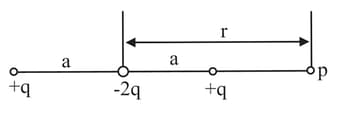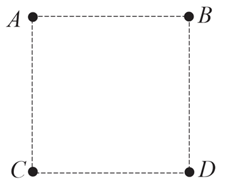Coulomb's Laws
Coulomb's Laws: Overview
This topic consists of various concepts like Coulomb's Law,Electrostatic Force between Two Charges in Vacuum,Coulomb's Law in Vector Form, etc.
Important Questions on Coulomb's Laws
The positive permittivity of the dielectric means is represented as-
Two protons move parallel to each other, keeping distance r between them, both moving with same velocity . Then the ratio of the electric and magnetic force of interaction between them is
Two fixed point charges units are separated by a distance ‘a’. Where should the third point charge be placed for it to be in equilibrium?
How does the coulomb force between two point charges depend upon the dielectric constant of the intervening medium?
The force of interaction between two chargesand placed at a separation is is. Then force of interaction between two charges and , placed at a separation , is
Determine the electric field intensity at point P due to quadruple distribution shown in figure for .

If the net force on is zero, find the relation between and .

Two point charges and are placed at a certain distance apart in the same order. Where should a third point charge be placed so that it is in equilibrium?
According to Coulomb's law, which is the correct relation for the following figure?

Two point charges having equal charges separated by distance experience a force of . What will be the force experienced by them if they are held in water at the same distance? (Given, ).
Find the electric field intensity at an axial point due to a charged disc.
A charge is placed at the centre of the line joining two equal charges . If the system of charges be in equilibrium, then find minimum value of charge from the given options. (charge of an electron)
Find the charge on charge as shown in the figure:

Two identical charges each are kept at a distance apart. third charge is placed at equilibrium. Find the position, nature and magnitude of the charge.
If and experience an electrical force of , calculate the separation between them. Also, calculate the force on by .
Three point charges lie on a straight line, as shown in the figure. Find the magnitude of resultant force exerted on the charge in newton.

A charge of is to be divided into two. The distance between the two divided charges is constant. Calculate the magnitude of the divided charges so that the force between them is maximum.
Force of attraction between two point charges and separated by is . When these charges are placed on two identical spheres of radius whose centres are apart, the force of attraction between them is
Four charges are at the corners of a square as shown in the figure. Corners A and D have equal charge, while both B and C have a charge of . What is the charge on A so that the force on B is zero?

Find the value of the net electric force on charge as shown in the following figure.

